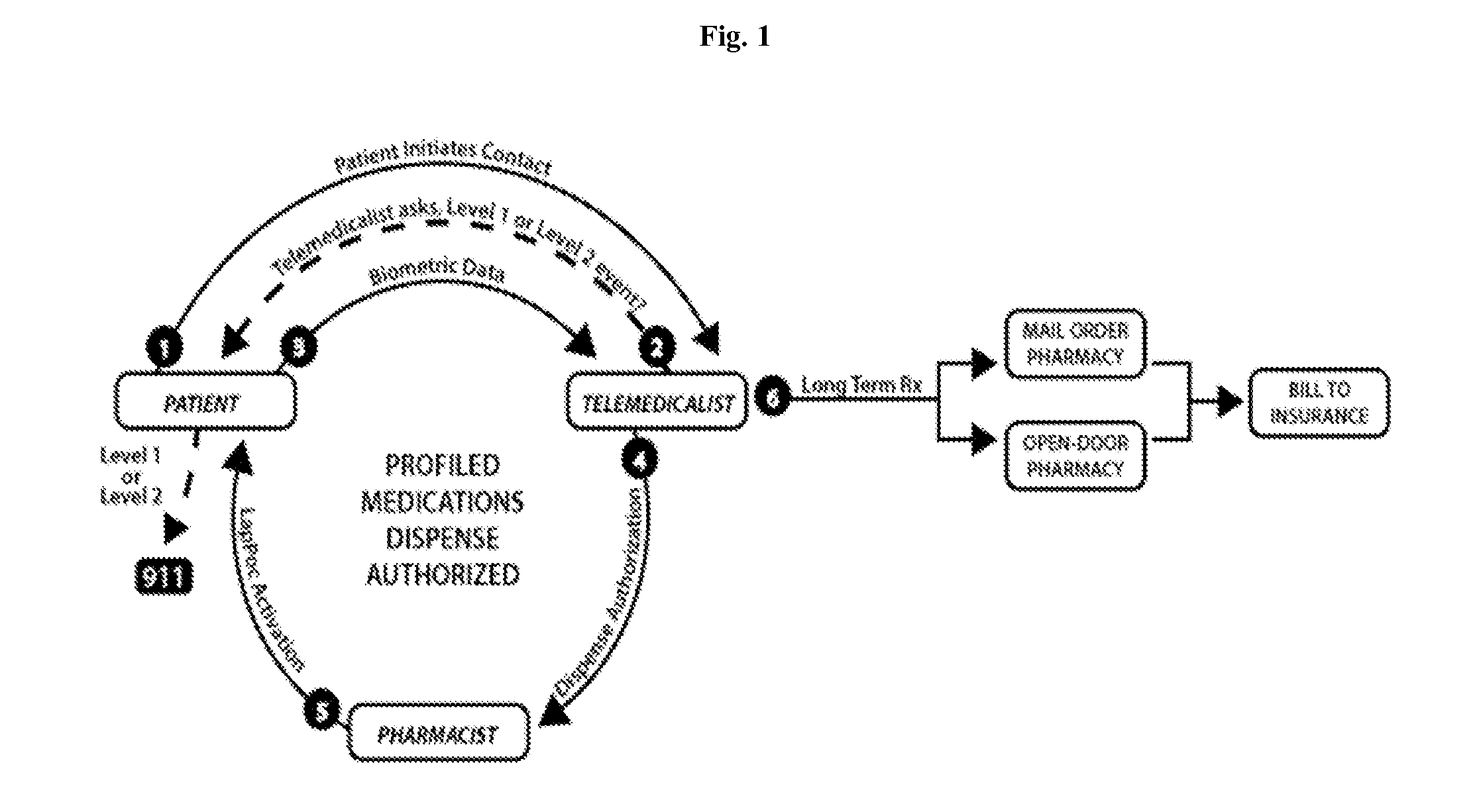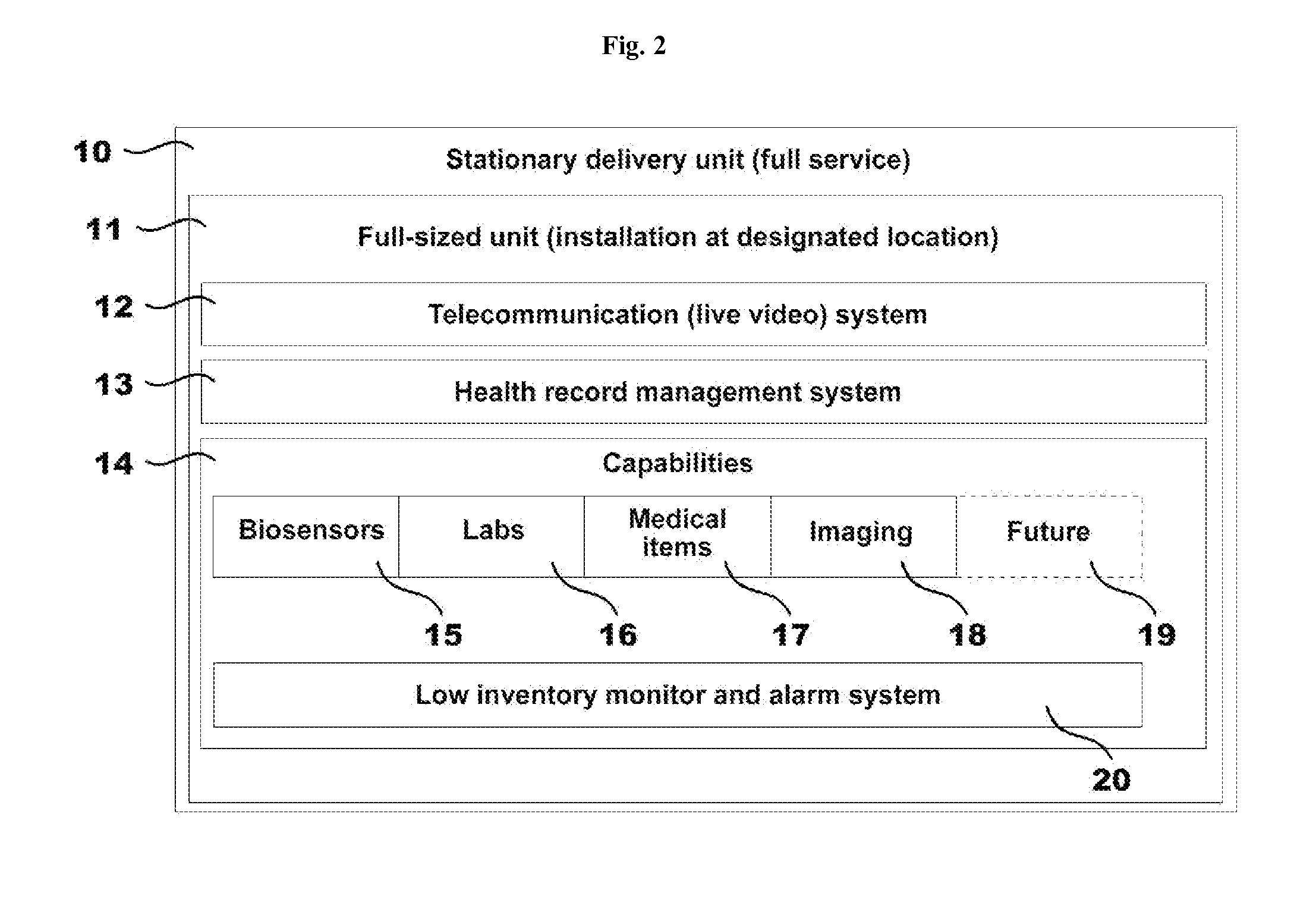Remotely-executed medical diagnosis and therapy including emergency automation
a technology of remote execution and medical diagnosis, applied in the field of remote execution of medical diagnosis and therapy including emergency automation, can solve the problems of lack of access, lack of adequate access, and inadequate access to healthcare for many individuals and families
- Summary
- Abstract
- Description
- Claims
- Application Information
AI Technical Summary
Benefits of technology
Problems solved by technology
Method used
Image
Examples
example 1
Installation of Kiosk in a Pharmacy
[0298]A retail pharmacy outlet installs a computer-based kiosk for providing remote medical diagnosis and therapy to their customers, which is part of a larger system for the same purpose. The kiosk includes a module for telecommunications and is connected to the Internet via an Ethernet interface. The module for telecommunications provides audio / video conferencing between the pharmacy's customers and a live, licensed healthcare provider who monitors the system from a remote location outside the United States. The kiosk installation also includes an array of five biosensors chosen to address health issues common in the population that patronizes the pharmacy outlet. The biosensors include a digital scale, a HD video camera, a blood pressure monitor (e.g., sphygmomanometer), a pulse oximeter (e.g., saturometer), and a blood glucose monitor. The sensors are operated by the user and the remote healthcare provider working in concert and coordinating th...
example 2
Use of Pharmacy Kiosk
[0300]A 57-year-old pharmacy customer approaches the kiosk of Example 1 and engages the system by swiping an outpatient, urgent care insurance card. His outpatient, urgent care insurance policy grants him access to the services of the kiosk 24 hours a day. A software module within the kiosk queries a remote database to verify the identity and insurance of the customer.
[0301]Prior to this, a physician logged into the system by approaching a work station while carrying an RFID identification card. The physician is licensed to practice medicine in the state where the kiosk is installed. When the customer engages the system, his complete medical record appears on a display screen for the physician's review. The physician sees that the customer has type 2 diabetes and has a history of poor compliance with diet instructions and his prescribed medication regimen. When the physician is ready, she initiates a live audio / video conference with the customer. The kiosk inclu...
example 3
Professional Triage Answering Service
[0303]A 50-year-old, male patient experiences shortness of breath after a leisurely walk on a Saturday morning. He has experienced prior heart problems so he immediately calls his cardiologist. Unfortunately, his cardiologist does not regularly see patients on weekends. However, the cardiologist's group has partnered with a professional triage answering service to provide a professional answering service during non-working hours. During non-working hours, calls are directed to a nurse practitioner (NP) who can provide basic medical care. The cardiologist's group had previously verified the NP's credentials by interviewing the NP and checking her medical malpractice insurance coverage, professional references, legal and prescription licenses, and state of licensure. The NP answers the patient's call and notes the symptoms. Using a software program, the NP accesses the group's electronic health records including the patient's previous medical histo...
PUM
 Login to View More
Login to View More Abstract
Description
Claims
Application Information
 Login to View More
Login to View More - R&D
- Intellectual Property
- Life Sciences
- Materials
- Tech Scout
- Unparalleled Data Quality
- Higher Quality Content
- 60% Fewer Hallucinations
Browse by: Latest US Patents, China's latest patents, Technical Efficacy Thesaurus, Application Domain, Technology Topic, Popular Technical Reports.
© 2025 PatSnap. All rights reserved.Legal|Privacy policy|Modern Slavery Act Transparency Statement|Sitemap|About US| Contact US: help@patsnap.com



